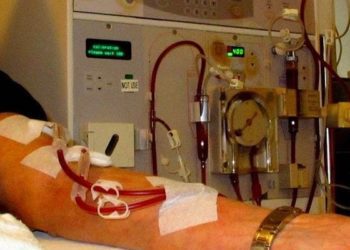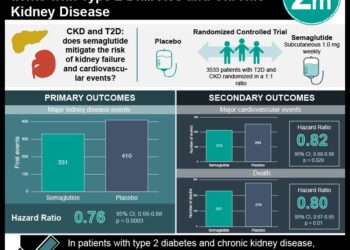Drug ameliorates effects of chronic kidney disease by targeting cell cytoskeleton [PreClinical]
1. Depletion of dynamin, a protein involved in maintenance of the actin cytoskeleton, resulted in decreased circulation of large proteins in zebrafish, which modeled the presence of protein in patient urine (proteinuria).
2. Administration of the small molecule Bis-T-23, which induces dynamin activity, reduced both transient and chronic proteinuria in zebrafish and mouse models of kidney dysfunction.
Evidence Rating Level: 2 (Good)
Study Rundown: Chronic kidney disease (CKD) affects millions of Americans, but treatments often target symptoms rather than underlying causes. CKD is characterized by poor filtration by the glomeruli, meshes of capillaries within the kidney. Wrapped around the glomeruli are podocytes, specialized epithelial cells whose actin-based protrusions, or foot processes, are effaced in CKD. The researchers of this study focused on dynamin, which was previously shown to be essential to podocyte function due to its important roles in regulating the actin cytoskeleton.
Suppressing dynamin production in zebrafish models resulted in a loss of podocyte foot processes and altered protein levels, typical features of CKD. Treatment with Bis-T-23 to promote dynamin elongation activity restored podocyte function. Bis-T-23 treatment also suppressed transient induced proteinuria in mice over several hours and restored the actin cytoskeleton in podocytes from these mice. Similar effects were observed in several genetic mouse models of CKD, with one model showing increased survival in treated as compared to untreated CKD mice. Bis-T-23 was also able to reduce proteinuria in a mouse model of diabetes-induced kidney dysfunction.
This work represents a novel, mechanistic approach to treating CKD which may be effective at treating CKD deriving from a variety of causes. Because dynamin is ubiquitous in the cells of the human body, Bis-T-23 treatment may have systemic effects. Further development of Bis-T-23 for clinical use will require demonstration of drug or formulation specificity toward podocytes.
Click to read the study in Nature Medicine
Relevant Reading: Proteolytic processing of dynamin by cytoplasmic cathepsin L is a mechanism for proteinuric kidney disease
In-Depth [animal study]: This study used a variety of animal models to assess the potential of targeting dynamin with Bis-T-23 to restore kidney function. First, the role of dynamin in kidney function was confirmed. Silencing zebrafish dynamin-2 gene expression led to podocyte foot process effacement. The animals also showed decreased fluorescence of circulating eGFP-tagged vitamin D-binding protein (eGFP-DBP) in the retina, indicating increased proteinuria (n=100-150 per group; p<0.001). In similar experiments, zebrafish with defective forms of dynamin showed lowered eGFP-DBP fluorescence. Fluorescence recovered to baseline levels when animals were treated with Bis-T-23 (n=40-150 per group; p<0.01 or p<0.001 depending on the type of dynamin).
In a separate animal model, mice were injected with lipopolysaccharide at 0 and 24 hours to induce transient proteinuria. Proteinuria was evident at 48-56 hours from high albumin/creatinine ratios (ACRs). Treatment with 40mg/kg Bis-T-23 at 48 hours significantly lowered proteinuria at 50-56 hour time points, especially at 50 and 52 hours (n=10 per group; p<0.001).
Mice homozygous for a point mutation in the α-actinin 4 protein were used as a genetic model of CKD. Four hours after treatment with 40mg/kg Bis-T-23, ACRs were decreased in treated mice compared to controls (n=8 per group; p<0.01). Another genetic model of CKD tested was mice with defective filtration at podocyte foot processes. Daily Bis-T-23 treatment for 6 days drastically reduced ACRs (n=5 per group; p<0.001 during the 3 days post-treatment). Treated mice also showed increased survival over controls (p<0.02).
In a final mouse model of kidney injury, diabetes was induced using streptozotocin and proteinuria subsequently developed over the course of several months. Daily Bis-T-23 treatment for 8 days significantly reduced proteinuria (n=8 per group; p<0.01).
Image: PD
©2015 2 Minute Medicine, Inc. All rights reserved. No works may be reproduced without expressed written consent from 2 Minute Medicine, Inc. Inquire about licensing here. No article should be construed as medical advice and is not intended as such by the authors or by 2 Minute Medicine, Inc.




![ABCD2 Score: Predicting Early Stroke Risk After Transient Ischemic Attack (TIA) [Classics Series]](https://www.2minutemedicine.com/wp-content/uploads/2013/05/web-cover-classics-with-logo-medicine-BW-small-jpg-75x75.jpg)


